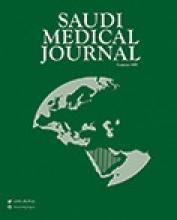Abstract
OBJECTIVE: Laparoscopic cholecystectomy is now widely applied in hospitals throughout the Kingdom of Saudi Arabia (KSA). Iatrogenic bile duct injury occurs rarely. It is a serious complication with long term consequences on patients. This paper describes our experience in dealing with this complication and the eventual outcome of the patients.
METHODS: Between July 1993 and December 1999, 17 patients with high bile duct injury were referred to the Hepatobiliary Unit of King Khalid University Hospital and King Fahad National Guard Hospital, Riyadh, KSA. Their charts were reviewed retrospectively. Once a patient was referred, a clinical evaluation with particular attention to the presence of sepsis was made. The anatomy of biliary duct was then delineated. Corrective surgery was attempted through hepaticojejunostomy. Follow up was at least 3 years in all cases.
RESULTS: There were 15 females and 2 males with an average age of 37 years. Eleven patients presented with bile duct injury and 6 had a stricture following an attempted repair. Five patients had Bismuth type E2 injury and the rest were higher (E3, E4, E5). Re-stricture occurred in 7 patients, 3 of them had concomitant arterial injury. All responded to radiological manipulation.
CONCLUSION: High bile duct injury following laparoscopic cholecystectomy is a devastating complication, with a high rate of recurrence after repair. Care of such patient should be carried out in a specialized unit with a strict follow up to try to avoid end stage liver failure requiring liver transplantation.
- Copyright: © Saudi Medical Journal
This is an open-access article distributed under the terms of the Creative Commons Attribution-Noncommercial-Share Alike 3.0 Unported, which permits unrestricted use, distribution, and reproduction in any medium, provided the original work is properly cited.






